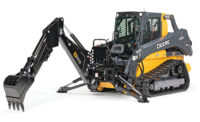The U.S. Occupational Safety and Health Administration is considering updating a warning issued in August about the hazards of unexpected release of excavator buckets attached with new quick-coupling devices.
Contractors should be aware of the potential problem with the couplers when they are considering buying new machinery, says David Ippolito, director of OSHAs office of Service and Technology Assessment.
Following an accident last year, OSHA staff reviewed data and found 15 incidents since January 1998 that involved the unanticipated release of excavator buckets from quick couplers on hydraulic excavators. Eight workers died in these incidents, according to OSHAs Safety and Health Information Bulletin.
Manufacturers that have added the quick-coupling feature use different methods for proprietary reasons, and operators are expected to know how to use all of them properly. Quick-coupling is credited with making excavators more versatile, say equipment experts. North American sales last year reached 24,000 units, says Chuck Yengst, president of Wilton, Conn.-based machinery market research firm Yengst Associates Inc.
OSHA says one fatal accident in Wisconsin in the last year occurred when the excavator operator changed buckets using a quick coupler but failed to manually install a locking pin. Its easy for operators to become confused, some say. "If you change from [using] a Cat to a John Deere, youre definitely going to have different couplers and some different safety measures to deal with," says Yengst. "They are not all the same. Two or three attachments go with each excavator."
Attachments have become important during the last five years, mostly for increased productivity and versatility, says Frank Manfredi, an industry analyst based in Mundelein, Ill. While a "pin-grabber," which is controlled by the machine operator from the cab, is the most common type of coupling device, it is by no means universal, he says.
A typical machine is sold with a bucket, and the other attachments can include hydraulic breakers, for breaking concrete; the three-pronged "thumb" attachment, used for picking up boulders and large objects; a vibrating plate for tamping earth; and a "pulverizer," which is used to crumble rebar-reinforced concrete in demolition projects.
OSHA says manufacturers have cut the chance of an accident by retrofitting existing quick couplers, designing new and improved ones and developing better safety procedures.
But not all employers and contractors using quick couplers are aware of the hazard and the manufacturers corrective actions, OSHA adds. Says Ippolito: Contractors "have to look at who will be doing the connections and how they should be trained."



Post a comment to this article
Report Abusive Comment